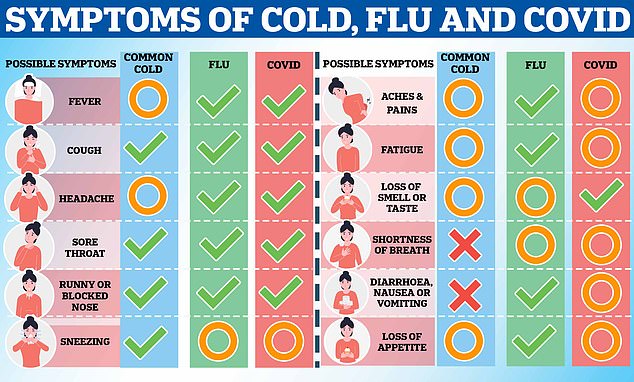Do you feel like everyone is getting sick lately? The latest CDC maps show that dozens of states remain hot spots for flu and stomach flu
We may be entering spring, but parts of America are still plagued by flu and other infections.
Ohio, Nebraska, New Mexico, Michigan and Arkansas have “very high” levels of flu activity — the highest numbers of people presenting to the doctor with flu-like symptoms — the CDC’s latest weekly report shows.
And many other states have “high” levels of respiratory illness, the data showed — the same number as the week before.
At the same time, norovirus, better known as the stomach flu, is spreading rapidly across the Northeast, putting “lives on hold” in some areas.
Ohio, Nebraska, New Mexico, Michigan and Arkansas have ‘very high’ levels of flu activity, the CDC’s latest weekly report showed

Based on the latest CDC data, which collects information from 3,400 hospitals across the country, just over 14 percent of tests in the U.S. came back positive for flu in the week ending Feb. 24, a slight decline compared to the week before.

Graphic shows the common symptoms (green check mark), occasional and possible symptoms (orange circle) and the symptoms that never occur (red cross) for colds, flu and Covid
The latest data from the CDC showed that in early February, nearly 14 percent of tests in the region were positive for norovirus — up from about four percent in November before the outbreak began.
While high infection rates are not unusual for this time of year, doctors have said many people are more seriously ill than usual due to lockdowns and social isolation during the pandemic, which has led to weakened immunity.
During the week ending Feb. 24, more than 16 percent of tests were positive for norovirus, CDC data showed. Positivity rates in the Northeast were more than 13 percent last month.
Norovirus spreads easily through contact with contaminated surfaces and then by touching the area around the mouth or nose.
Infections usually cause gastrointestinal complaints, such as abdominal pain and watery diarrhea, but also fever and headache.
In the vast majority of cases, symptoms resolve within two days, requiring little treatment other than bed rest.
Ohio, which currently has the most people presenting to the doctor with flu-like symptoms than anywhere else in America, has seen a six percent increase in respiratory illnesses since the previous week.
The rate of flu hospitalizations is 51 per 100,000 inhabitants.
Two more children died from the flu in the week ending February 24, bringing the total to 93 pediatric deaths since the start of the flu season last October.
As of October 31, 2023, approximately 174 deaths have been reported for the 2022-2023 flu season.
In the last flu season, the CDC estimated that there have been at least 26 million illnesses, 290,000 hospitalizations, and 18,000 deaths from flu so far.
During the 2022-2023 season, an estimated 31 million people were sick with the flu, with 14 million visits to a health care provider for flu, 360,000 hospitalizations for flu, and 21,000 deaths from flu.
Based on the latest CDC data, which collects information from 3,400 hospitals across the country, more than 14 percent of tests in the U.S. came back positive for flu in the week ending Feb. 24, down slightly from from the week before. .
The CDC’s surveillance system tracks doctor visits for respiratory illnesses, including fever, cough or sore throat.
Data from the Ohio Department of Health shows that flu-like illness rates are currently above the five-year average for this time of year.
The flu, caused by influenza viruses, usually causes people to cough, the most common crossover seasonal virus symptom.
Signs of the flu are usually much more intense than a cold and can even cause stomach problems.
It can be fatal in some cases if complications, such as pneumonia, occur among the most vulnerable.
Between October 1, 2023 and February 24, 2024, approximately 18,790 flu-related hospitalizations occurred.
Respiratory disease levels are typically highest in January and February due to the cold weather.
It comes as fears build on social media platforms over a ‘mystery virus’ that has caused Covid-like symptoms, despite many testing negative for the virus, as well as flu and RSV.
People described being sick for weeks with high fever, nausea, difficulty breathing, loss of sense of smell and fatigue.
But health experts say the virus is less mysterious than it is painted online.
Viruses circulate all year round, and this ‘mystery virus’ is probably one of the most common seasonal diseases suppressed during the Covid pandemic.
It is thought that there is a dual effect at play. People are hypersensitive to their own health after the pandemic, and our immune systems have been weakened by things like lockdowns and working from home, while we weren’t exposed to germs, which made illnesses feel more intense.
